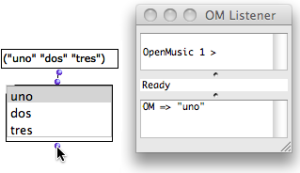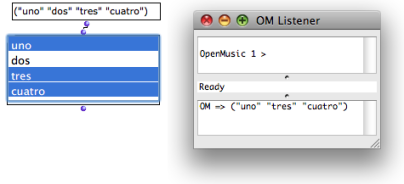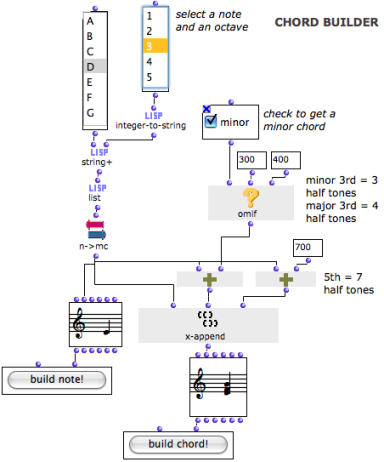Controlling Values (2) : List Selection Boxes
Features
 | Dialog items include two list selection boxes :
List selection boxes allow to select one or several items among a list, return and use it/them in downstream computations. They have one input and one output :
|
 | To set the content of a box :
When evaluated, the box returns the selected item. Note that inverted commas are not compulsory. |
Boxes
The single-item-list-box allows to select only one item at a time.
To select an item,
-
press
bto lock the box, -
click on an item.

This box allows to select one or more items, which are returned as a list.
The multi-item-list-box is edited and used as as single-item-list-box .
- To select consecutive items or all the items of the box,
SHIFTclick on the items or click and drag them. - To select independent items,
Cmdclick on them.

By default, the first item is selected and reset :
- when the box is assigned a new list of items,
- if the box is not locked.
A Musical Application : Building a Triad

The "chord builder" patch creates a minor or major triad, with three types of interface boxes : the multiple-items-list-box, the button-box, the check-box.
-
On the left, the
build note!button box calls a series of boxes :-
Two list-boxes allow to choose the name of a note, from A to G, and an octave index, from 1 to 5.
-
A list containing the resulting reference is created with three lisp functions and returned to n->mc1 , which returns a midicents value to a note box.
-
-
On the right, the
build chord!button box calls another series of boxes :-
The
minorcheck box is checked.It returns "true" to OMIF, which returns 300, the midicents value of a minor third. If it isn't checked, OMIF returns 400, the value of a major third.
-
The value of the initial note is added with 300 and 700 to build a minor triad, via two om+ boxes.
-
The resulting values are gathered by x-append into one single list and returned to a chord box.
-
- n->mc
Converts a note name or list of note names into corresponding midi cents values. The reference is the standard notation, where the medium C (6000 midicents) = C3.
